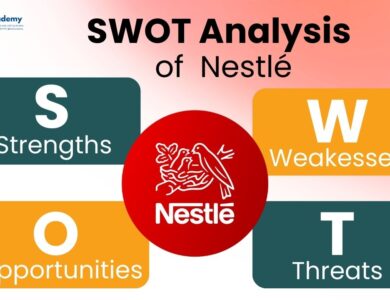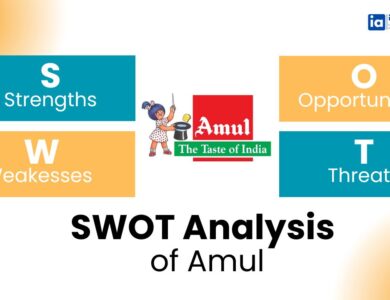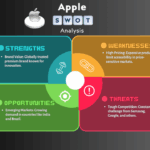SWOT Analysis of Samsung: Strategic Insights Into the Global Tech Giant
Discover the complete SWOT analysis of Samsung in 2025. Explore its global strengths, internal challenges, growth opportunities, and threats in an industry shaped by AI, innovation, and fierce competition.

From your smartphone and smart TV to memory chips powering your laptop—Samsung is everywhere. As one of the world’s most influential tech giants, Samsung has mastered the art of building, innovating, and dominating across multiple verticals.
But in 2025, the game is changing.
With AI transforming devices, geopolitics reshaping supply chains, and consumer expectations evolving fast, even tech titans like Samsung must stay ahead of the curve. This makes a SWOT analysis more relevant than ever.
In this article, we’ll explore Samsung’s Strengths, Weaknesses, Opportunities, and Threats—offering a sharp, strategic view of where it stands today, and where it’s headed tomorrow.
Let’s begin with a quick snapshot of Samsung’s business empire.
Learn AI & Digital Marketing,
Pay Fees After Placement
- ✅ Minimal Admission Fees
- ✅ No Loan or Income Sharing Agreement
- ✅ 100% Placement Support
- ✅ ISO & Govt Registered Certificate
- ✅ Practical 3+1 Months Duration
Get a free counseling call. We’ll guide you through learning, certification, and job placement.
Request a Free Call Back
Takes less than a minute.
Company Overview of Samsung
Samsung Electronics, a subsidiary of the South Korea–based Samsung Group, is one of the largest technology companies in the world. Founded in 1938, it has evolved from a trading company into a global leader in electronics, semiconductors, and smart devices.
As of 2025:
- Headquarters: Suwon, South Korea
- 2024 Revenue: Over $220 billion USD
- Employees: ~270,000 globally
- Key Segments:
- Mobile & smartphones (Galaxy series)
- Semiconductor (DRAM, NAND, SoCs)
- Consumer electronics (TVs, refrigerators, washing machines)
- Display panels (OLED, QLED)
- EV batteries and 3nm chip fabrication
Samsung is also known for its innovation in foldables, AI-integrated devices, and sustainable tech. Its Galaxy ecosystem, backed by massive R&D and supply chain control, makes it a formidable player in both consumer and industrial electronics.
From mass-market smartphones to next-gen chipsets, Samsung’s influence touches nearly every part of modern digital life.
What is a SWOT Analysis?
A SWOT analysis is a strategic tool that helps evaluate a company’s position in its industry by looking at four key areas:
- Strengths – Internal advantages that give the company a competitive edge
- Weaknesses – Internal limitations that may hinder growth
- Opportunities – External trends or shifts that the company can capitalize on
- Threats – External risks that could negatively impact performance
For a tech giant like Samsung, conducting a SWOT analysis in 2025 is vital. The company operates in hyper-competitive, innovation-driven industries, where speed, agility, and strategy are everything.
This framework allows us to assess how well Samsung is adapting to rapid changes in AI, semiconductors, smartphones, and global trade.
Strengths of Samsung
Samsung’s global dominance isn’t an accident—it’s the result of decades of technological leadership, smart vertical integration, and relentless R&D. In 2025, these strengths continue to power its position as one of the most valuable tech companies in the world.
Let’s dive into the core strengths that give Samsung its edge:
1. Market Leader in Smartphones and Semiconductors
Samsung consistently ranks as the #1 or #2 smartphone maker globally, with a strong presence in both flagship and mid-range segments (Galaxy S series, Galaxy A, and Foldables).
It’s also the world’s largest manufacturer of memory chips—DRAM, NAND, and SSDs—used by countless other tech firms.
2. Massive R&D Investment and Innovation Culture
In 2024 alone, Samsung invested over $20 billion in R&D. Its focus on foldable devices, 3nm chip tech, AI integration, and smart appliances puts it at the forefront of innovation.
It’s often the first to market with cutting-edge features like foldable phones and AI-powered TVs.
3. Diversified Product Portfolio
Unlike Apple or Xiaomi, Samsung doesn’t rely on one product category. Its range spans:
- Smartphones
- Laptops & tablets
- Home appliances
- TVs & displays
- Semiconductor chips
- EV batteries and components
This diversification provides revenue resilience.
4. Vertical Integration & Manufacturing Power
Samsung controls everything from chip production to display panels, allowing for better cost control, faster innovation, and fewer supply chain disruptions.
This in-house capacity also strengthens its competitive moat.
5. Global Brand Recognition and Reach
Samsung is a household name in over 180 countries. Its strong brand equity, aggressive marketing, and global retail presence keep it top-of-mind in both developed and emerging markets.
Competitor Comparison Table – 2025 Snapshot
| Company | FY 24–25 Revenue | Smartphone Market Share (Global) | Chip Business | R&D Spend (2024) | Ecosystem Strength |
|---|---|---|---|---|---|
| Samsung | $220B+ | ~19% | Strong | $20B+ | Broad (HW-driven) |
| Apple | $400B+ | ~21% | None (outsourced) | $28B+ | Very strong |
| Xiaomi | $50B+ | ~13% | Weak | $2B+ | Medium |
| Huawei | $60B+ (limited) | ~9% (China-focused) | Rebuilding | ~$20B | Medium (local) |
Data based on 2024–25 public reports and industry research.
Samsung’s strength lies in its ability to combine scale with agility, making it one of the few companies that can design, manufacture, and deliver across the entire tech value chain.
Weaknesses of Samsung
Despite its massive success and global footprint, Samsung faces several internal limitations that could impact its competitiveness—especially as the tech world becomes increasingly software- and ecosystem-driven.
Let’s look at the key weaknesses Samsung must overcome in 2025:
1. Dependence on Android Ecosystem
Unlike Apple, Samsung does not control the operating system its devices run on. It relies on Google’s Android, limiting its ability to fully integrate hardware and software for a seamless user experience.
2. Fragmented Software & User Experience
Samsung’s custom UI (One UI) has improved, but many users still find the bloatware, delayed updates, and inconsistent app experience a pain point—especially compared to iOS.
This affects loyalty among premium users.
3. Brand Perception Gap in Luxury Segment
While Samsung has flagship phones, it still lacks the luxury brand appeal of Apple. For many consumers, an iPhone is seen as a status symbol—something Samsung struggles to replicate globally.
4. High Exposure to Semiconductor Cycles
Samsung earns a large portion of its revenue from semiconductors—a sector known for booms and busts. Falling chip prices or overcapacity can significantly impact profits.
5. Weak Presence in Software & Services
Compared to Apple, Google, or Microsoft, Samsung is underdeveloped in digital services like:
-
Cloud storage
-
Subscriptions (music, video, productivity)
-
App ecosystems
-
AI assistants
This limits its recurring revenue potential.
While none of these weaknesses threaten Samsung’s core business, addressing them is critical for building long-term consumer lock-in, platform value, and high-margin growth.
Opportunities for Samsung
In a tech landscape defined by AI, sustainability, and digital convergence, Samsung has several clear opportunities to scale beyond hardware and unlock new business models in 2025 and beyond.
Let’s explore the most promising growth avenues:
1. AI-Integrated Devices Across Segments
Samsung is uniquely positioned to embed AI into its entire ecosystem—from smartphones and TVs to refrigerators and washing machines.
With tools like Galaxy AI and on-device AI processing, Samsung can deliver more personalized, predictive, and secure user experiences.
2. Leadership in Foldables and New Form Factors
Samsung remains the pioneer and global leader in foldable phones (Galaxy Z Fold and Flip series). With growing adoption, it can expand into hybrid laptops, tablets, and wearable foldables, redefining personal computing.
3. Growth in EV Batteries and 3nm Chips
Through Samsung SDI, the company is gaining ground in EV battery manufacturing—a market expected to explode this decade.
Meanwhile, Samsung Foundry’s 3nm and AI-optimized chips put it in direct competition with TSMC, offering huge upside in B2B tech.
4. Sustainability & Green Innovation
Samsung’s focus on carbon neutrality, eco-packaging, and energy-efficient devices aligns perfectly with consumer and regulatory expectations. Green innovation can become both a branding and compliance advantage.
5. Strategic Partnerships in Cloud, AI & Enterprise
Partnering with companies like Microsoft (cloud), NVIDIA (AI), and Google (Android) gives Samsung a chance to co-create next-gen B2B solutions and enterprise devices.
It can also expand its presence in smart cities, healthcare tech, and industrial IoT.
If Samsung capitalizes on these trends—especially AI, foldables, and sustainability—it can transform from a hardware leader to a holistic digital lifestyle enabler.
Threats to Samsung
While Samsung holds a dominant position in the global tech arena, it also operates in volatile, highly competitive, and geopolitically sensitive markets. These external threats could impact both its core business and future growth.
Let’s take a closer look at the key risks:
1. Intense Competition from Apple & Chinese Brands
Samsung is constantly challenged by:
- Apple in the premium smartphone and wearables market
- Xiaomi, Vivo, Oppo, and Huawei in budget and mid-range segments
- OnePlus and Google Pixel in the upper mid-tier
Each of these brands is innovating aggressively and squeezing margins across categories.
2. Geopolitical & Supply Chain Risks
Tensions in the U.S.–China tech war, instability in Taiwan or South Korea, and rising trade restrictions could affect:
- Chip exports
- Component sourcing
- Foundry partnerships
Samsung’s global operations are vulnerable to regulatory shifts and export bans.
3. Semiconductor Price Volatility
Memory chip prices (DRAM, NAND) are highly cyclical, and oversupply or weak demand can cause revenue dips. This directly affects Samsung’s semiconductor division, a major profit engine.
4. Declining Smartphone Margins
As the global smartphone market matures, margins are thinning. Users are holding phones longer, and budget brands are flooding the market—forcing Samsung to compete on price instead of innovation.
5. Cybersecurity & Data Privacy Concerns
As Samsung collects more user data across devices and platforms, it faces increasing scrutiny around privacy, security breaches, and regulatory compliance—especially in Europe (GDPR) and the U.S.
In short, Samsung must continue to innovate, diversify, and de-risk its global operations to stay resilient in a world of fast-moving disruptions.
Strategic Insights & Key Takeaways
Samsung in 2025 remains a global tech powerhouse with influence that spans industries—from consumer electronics and mobile to semiconductors and EV batteries. But its ability to lead the next decade depends on more than just hardware.
Here are the key insights from this SWOT analysis:
- Strengths like R&D muscle, vertical integration, and a diversified product line make Samsung incredibly resilient.
- But weaknesses in software services, UX cohesion, and luxury perception limit its ability to build deep ecosystem loyalty.
- Opportunities in foldables, AI-powered appliances, green tech, and 3nm chips could unlock massive new revenue streams.
- Yet it faces serious threats from geopolitical instability, Chinese competitors, and declining smartphone margins.
To remain dominant, Samsung must think beyond devices—and invest in services, platforms, and ecosystem-driven experiences that create recurring value and stronger brand attachment.
Conclusion
Samsung is not just a smartphone maker—it’s a global innovation engine that touches nearly every aspect of modern digital life. Whether it’s powering your TV, storing your data, or building the next AI-ready chip, Samsung continues to lead at the frontlines of technology.
But in 2025, dominance in hardware isn’t enough. To stay ahead, Samsung must build deeper ecosystems, scale smart services, and lead the shift toward green, AI-integrated living.
This SWOT analysis of Samsung shows a company with enormous strengths and even bigger potential. The question isn’t whether Samsung can stay in the race—it’s whether it can set the pace for the next generation of tech.
❓ FAQs – SWOT Analysis of Samsung
1. What is Samsung best known for?
Samsung is best known for its smartphones (Galaxy series), memory chips, OLED displays, and smart appliances. It is also a global leader in foldable technology and semiconductor manufacturing.
2. How does Samsung compare with Apple?
While Apple focuses on a tight ecosystem and high-margin devices, Samsung excels in diversity, vertical integration, and hardware innovation. However, Apple has stronger software and service revenues.
3. Is Samsung involved in EV batteries and chip manufacturing?
Yes. Through Samsung SDI, it manufactures EV batteries, and via Samsung Foundry, it produces advanced semiconductors (3nm and beyond).
4. What are Samsung’s fastest-growing areas in 2025?
Foldable smartphones, AI-powered appliances, EV battery tech, and 3nm chip production are among its key growth drivers this year.





